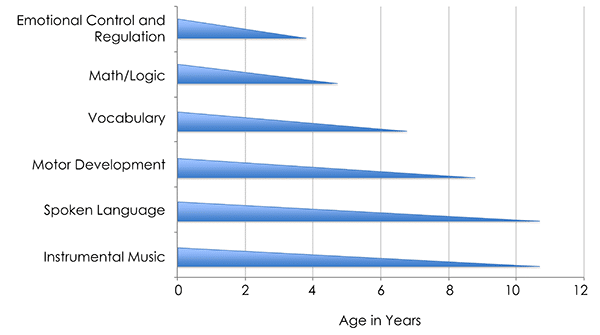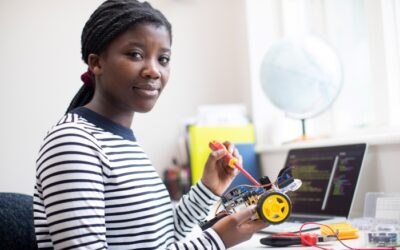Windows of Opportunity are Sensitive Periods of Learning
Windows of opportunity are important stretches of time in which a young brain responds to certain types of input to create neural networks. Neural networks are the paths that our brain uses to help us make decisions and take actions regarding what we see, what we like, and what we do.
The brain is a remarkable organ. Learning occurs throughout our lives, so the brain is always undergoing changes. But there are certain times during a person’s life when the brain is at its highest plasticity—able to modify its own structure to make new connections and strengthen existing ones.
At Raising Families, we describe these times as “Windows of Opportunity.” By knowing when these periods are, you can harness this built-in fast track to learning and receive the biggest return for your efforts.

Emotional Control (0–4 years):
The best time to focus on helping your child recognize and understand their emotions is from birth until they are about four years old.
No one is born with highly developed emotional intelligence. Parents and caretakers must be aware and sensitive to help children carefully develop the skills involved. These earliest years, when the brain is rapidly forming, are crucial for the child’s lifelong emotional capacity and maturity.
The next time your child has a strong emotion, talk about it. Name the emotion it looks like they are feeling, and describe how that same feeling makes you feel. Let them know it’s okay to feel that way, and if it’s a negative emotion, some ways they can process it and move on.
In The Readiness Profile we highlight many key milestones of emotional development, like when children start to feel empathy, when they begin to understand the concept of sharing, when they begin to have impulse control, and so on.
Math/Logic (0–5 years):
Do you think numbers and logic are “hard”? You may have been unintentionally trained to think so by other adults when you were younger before you even had a chance to try learning for yourself. It’s an unfortunate and still common practice.
What is known is that when we help kids learn about numbers and logic in context (in real life) when they are young, it significantly strengthens their confidence in math and logic as they get older.
Next time you go to the grocery store, talk to your kids about how much things cost and why you buy what you do.
We have an entire workbook to give you ideas on how to use the everyday task of feeding your family as a way to develop personal responsibilities with the unmentioned benefit of really improving their math and logic skills.
Between ages three and five is a great time to establish the foundation that creates the neural network foundation for long-term capabilities. Remember, the more neural networks your kids have in their brains, the better their capabilities and capacities.
Vocabulary (0–7 years):
Talk, talk, talk! To your kids, that is, and read to them! The more language they hear to explain the world around them, the better their vocabulary and capacity for language will be as they grow.
Motor Development (0–9 years):
Motor development through physical movement is key to all of the other areas on the chart for at least two key reasons.
- Movement significantly increases the number of neural pathways. The more your kids move, the better.
- When kids move, they aren’t just swinging their arms and legs. Their other senses are put to work as well. This increases and strengthens, yet again, the number of neural networks.
Spoken Language and Instrumental Movement (0–11 years):
With strong foundations, the number of neural networks (think of it as brainpower) from emotional control and regulation, logic, vocabulary, and movement, the better your kids will be at spoken language and if they choose, learning to play a musical instrument.
Both require some real brainpower because of all the parts of the brain that need to fire at the same time to be successful at both.
Don’t worry if your children are aged out of a certain window. You haven’t missed your ONLY opportunity to help them. We don’t stop developing capabilities in emotional regulation, math/logic, vocabulary, motor development, spoken language, and instrumental music when we age out of the window. Rather, developing exceptional skills in those areas just gets incrementally more difficult, but they are certainly still achievable.
Just like in the toddler years, adolescence is a time in which the human brain is primed to learn through experience.
The First Window
- Physical – learning to crawl then walk
- Cognitive – learning to speak and process language
- Emotional – learning self-evaluation
The Second Window
However, as the child gets older, there is a second window in which there is increased learning that is focused on:
- Social skills – learning to interact with others
- Responsibility – learning to value your contribution to a larger group
- Life skills – taking care of yourself
What’s Happening to My Teen?
Any parent of a teen knows that these years are full of changes. We often think of the physical changes that occur at this time, but we must recognize the incredible changes also occurring in the teen’s brain.
As a child reaches adolescence, the prefrontal cortex in the brain continues to develop and mature with a significant growth spurt just before puberty. This means that well used connections in the brain are strengthened while the unused (and therefore deemed unnecessary by the brain) connections are pruned away for the sake of efficiency.
Example: learning to play an instrument well during this window will likely result in a lifetime of ability.
Learning through doing and continuous repetition strengthens skills.
What You Can Do to Help
Anchor your children in the world around them to make them better people.
Engage a child’s brain in learning and repeating the social skills, responsibility, and life skills that must be attained during this time. You can facilitate a regular stream of real-life experience to which they can apply their expanding cognitive and social capabilities.
Examples:
- Take your teen to vote with you; to a city council meeting; to Washington D.C.
- Take your child to a laundry mat so they understand the use of industrial machines and how to wash their clothes in the dorm.
- Talk to your teen about the charitable donations you choose to make and why.
- Discuss what it means to be a good friend and focus attention on the world outside of their immediate sphere.
- Don’t shy away from having challenging discussions with your teenager. There are gentle ways, through tone of voice, agreements of actions and timelines and consequences, that can make the exchange in a challenging conversation less heated and more respectful on both sides. Discuss what you expect of one another. This will teach them to better handle conflict with others as they grow more independent.
Take Advantage of Your Time Together
Adolescence is an in-between time when a person gets the experience they need to begin to grow into a functioning adult of the future. After the window closes it becomes much harder to teach the “old dog new tricks.”
The brain’s plasticity and resilience enable learning anything at any time later in life, too. But what is learned during windows of opportunity can be learned masterfully. Make sure the first thing your child learns about social skills, responsibility, and life skills are what you want him or her to know and practice for the rest of their lives.
Maximize Your Child’s Learning Potential
- Our brain grows, and as a result, the number of neural networks grows as well.
- If neural networks don’t get used, our body has a natural mechanism for eliminating the synapses that connect those networks. Over time, if we don’t exercise certain parts of our brain, like if we don’t exercise our other muscles, we lose capabilities.
- Neural networks and synapses can be restored because of what is called brain plasticity, but it takes a focused effort to make that happen. Ever wonder why kids can learn a new language in school but for adults, it can be really challenging? It’s because we have to recreate the neural networks relating to spoken language that got eliminated because we didn’t use them.
By sharing these windows of opportunity with you, we hope to steer you in the right direction when it comes to helping your child maximize their learning potential and what areas to focus on when.
Make sure you download The Readiness Profile so you know when these windows of opportunity occur, and you can make the most of them.
Guidebook
The Readiness Profile
-
- A comprehensive guide to five fundamental areas of your child’s development from birth to age 18.
- Perfect for parents and caregivers looking for an integrated guide to child development focused on the whole child, not just one area at a time.
- Learn key details and actionable steps to promote physical, cognitive, emotional, social, and life skills development at any time from birth to age 18.
What To Do Next
1. Read more in the blog:
The Family Wisdom Blog shares valuable ideas across diverse topics.
2. Explore the Printables Library:
Our printables library is filled with must-have activity ideas, checklists, guides, and workbooks.
3. Subscribe to Our Newsletter:
Sign up for our newsletter for parenting tips to help you create the family team you've always wanted.
Rick Stephens
Rick Stephens is a co-founder of Raising Families. With 33 years of experience as a top-level executive at The Boeing Company and having raised four children of his own, he is able to support parents and grandparents by incorporating his knowledge of business, leadership, and complex systems into the family setting.
In his free time Rick enjoys road biking, scuba diving, visiting his grandkids, and generally trying to figure out which time zone he’s in this week. Read full bio >>







